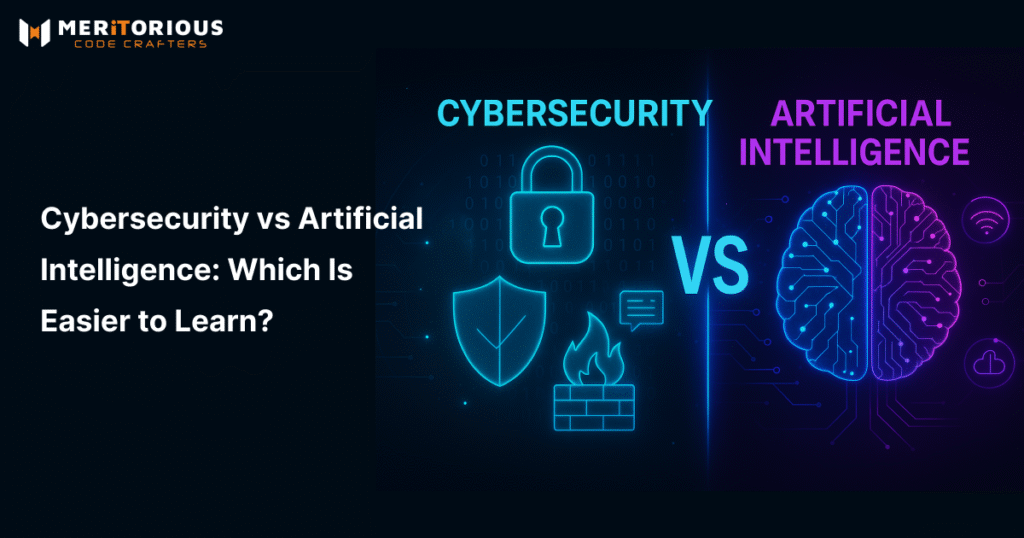In today’s digital world, both cybersecurity or artificial intelligence (AI) play pivotal roles. But for beginners, the question often arises: which of these fields is easier to grasp? This article will explore the basics of each area, their applications, and offer some guidance on which might be simpler to dive into for newcomers.
Understanding Cybersecurity or artificial intelligence
Cybersecurity is the practice of protecting systems, networks, and programs from digital attacks. These attacks usually aim to access, change, or destroy sensitive information. Cybersecurity can be seen as a digital shield that defends against malicious activities.
Cybersecurity Basics
At its core, cybersecurity involves several key components:
- Network Security: Protecting the integrity of networks and data during use. This involves setting up firewalls, intrusion detection systems, and implementing robust network protocols to ensure data flows securely between devices. Network security is the frontline defense against unauthorized access and attacks.
- Application Security: Keeping software and devices free of threats. This requires developing secure code, conducting regular security assessments, and updating software to patch vulnerabilities. Application security ensures that applications function as intended and resist exploitation.
- Information Security: Protecting data integrity and privacy during storage and transmission. It involves encryption methods, access controls, and data loss prevention strategies to secure sensitive data. Information security is crucial for maintaining confidentiality and trust in digital transactions.
- Operational Security: Handling and protecting data assets. This includes policies and procedures that govern how data is accessed and handled, as well as ensuring that employees are trained in security best practices. Operational security is about establishing a culture of security awareness within organizations.
Cybersecurity requires a combination of technical skills and an understanding of potential threats. Often, it involves being proactive in identifying vulnerabilities before they are exploited. Professionals need to stay informed about the latest threat vectors and continuously update their skills to protect against them.
Cybersecurity Tips for Beginners
- Start with Basics: Learn about malware, phishing, and basic network security principles. Understanding these foundational elements helps you recognize common threats and take preventative measures. Beginners should focus on familiarizing themselves with the language and tools of the trade.
- Use Easy Tools: Tools like antivirus software and firewalls are great starting points. These tools offer a straightforward way to enhance security without requiring deep technical expertise. They provide a practical introduction to how cybersecurity measures are implemented.
- Stay Updated: Cyber threats evolve rapidly; regular learning is crucial. Following cybersecurity news, participating in online forums, and attending workshops can keep your knowledge current. Continuous education is vital as attackers constantly develop new tactics.
- Engage in Simulations: Participate in cybersecurity simulations and labs to apply your knowledge in a controlled environment. These exercises help build confidence and provide hands-on experience in dealing with real-world scenarios.
- Join Communities: Engage with cybersecurity communities and networks to learn from experienced professionals. These groups offer valuable insights, mentorship opportunities, and resources for further study.
Delving into Artificial Intelligence
Artificial Intelligence, on the other hand, involves creating systems capable of performing tasks that usually require human intelligence. These tasks include learning, reasoning, problem-solving, perception, and language understanding.
Simple AI Applications
AI technology is diverse and can be seen in everyday tools:
- Chatbots: Used in customer service to provide quick responses. Chatbots use natural language processing to understand and respond to user queries, enhancing customer experiences by offering instant support. They automate repetitive tasks, allowing human agents to focus on more complex issues.
- Recommendation Systems: Used by streaming services like Netflix to suggest content. These systems analyze user behavior and preferences to offer personalized content, improving user engagement and satisfaction. Recommendation systems are pivotal in driving user interaction and retention.
- Voice Assistants: Such as Alexa or Siri, which help with everyday tasks. These AI-powered assistants can perform a wide range of functions, from setting reminders to controlling smart home devices, all through voice commands. Voice assistants enhance convenience and accessibility in daily life.
- Image Recognition: AI technologies that identify and classify images. This application is widely used in security systems, medical diagnostics, and social media platforms to automatically tag and organize images.
- Predictive Text: AI used in messaging apps and emails to suggest words and phrases. Predictive text speeds up communication by learning user typing habits and offering appropriate suggestions.
Easy AI Tools for Beginners
For those new to AI, there are tools that simplify the learning process:
- Google’s Teachable Machine: A web-based tool that makes machine learning accessible. It allows users to train simple models using their own data, without requiring programming knowledge. This tool is perfect for experimenting with AI concepts in a user-friendly environment.
- Scratch with AI Extensions: Allows creation of simple AI applications with visual programming. Scratch is a block-based coding platform that introduces AI concepts through interactive projects, making it ideal for beginners and younger audiences.
- TensorFlow Lite: A lightweight version of TensorFlow designed for mobile and embedded devices. It offers pre-trained models and easy-to-use APIs, enabling beginners to deploy AI models on various platforms.
- IBM Watson Studio: Provides tools and resources to build AI models without deep programming skills. It offers a collaborative environment for data scientists and developers to create, train, and deploy AI models.
- Azure Machine Learning Studio: A cloud-based platform offering drag-and-drop features to build, test, and deploy machine learning models. It simplifies the AI development process, making it accessible to newcomers.
Comparing Cybersecurity and AI
When comparing the ease of learning cybersecurity versus AI, it boils down to personal interest and skill set. Both fields require commitment and continuous learning, but here are some points to consider:
Learning Curve
- Cybersecurity: Involves understanding networks and systems, which can be technical but straightforward. Beginners might find it easier to grasp the foundational concepts. The learning path is often structured, with clear guidelines and certifications to track progress.
- AI: Requires a grasp of algorithms, data handling, and sometimes programming. It can be more abstract and complex initially. The field demands creativity and problem-solving skills to develop innovative solutions.
- Skill Overlap: Both fields share common skills such as analytical thinking and problem-solving, which are crucial in identifying patterns and devising solutions.
Practical Applications
- Cybersecurity: Focused on protecting data, which is crucial in every industry. Its practical applications are evident in securing personal information, financial transactions, and critical infrastructure. Cybersecurity measures are essential for maintaining trust in digital environments.
- AI: Involves creating smarter applications and systems, useful in automation and data analysis. Its applications are diverse, ranging from improving business operations to enhancing user experiences. AI technologies are transforming industries by enabling data-driven decision-making.
- Integration: Both fields increasingly intersect, with AI being used to enhance cybersecurity measures, showcasing the potential for cross-disciplinary applications.
Job Opportunities
Both fields offer lucrative career paths, but the demand can vary:
- Cybersecurity: Growing need for security professionals due to increasing cyber threats. The demand is driven by the rise in cybercrime and the need for robust defenses, leading to numerous job opportunities across sectors.
- AI: High demand for skills in AI development and integration across various sectors. As businesses seek to innovate and automate, the need for AI expertise continues to expand, offering diverse career paths.
- Career Growth: Both fields offer opportunities for specialization and advancement, with potential for leadership roles and influence in shaping technological futures.
AI in Security: Bridging the Gap
Interestingly, AI is making significant inroads into cybersecurity. AI in security is about using intelligent systems to predict and counteract cyber threats.
AI Cybersecurity Benefits
- Anomaly Detection: AI can identify unusual patterns that might indicate a threat. By analyzing vast amounts of data, AI systems can detect deviations from normal behavior, allowing for early intervention. This capability enhances threat detection accuracy and reduces false positives.
- Automated Responses: AI can automatically respond to certain threats, reducing reaction time. Automated systems can execute predefined actions to mitigate risks, ensuring swift and efficient threat management. This reduces the burden on human operators and enhances overall security posture.
- Predictive Analytics: Helps in anticipating potential security breaches before they occur. By leveraging machine learning algorithms, AI can forecast future threats based on historical data and trends. Predictive analytics enable organizations to adopt a proactive approach to cybersecurity.
- Threat Intelligence: AI systems can analyze threat intelligence feeds to identify emerging threats. This capability allows for timely updates to security protocols and defenses, keeping organizations one step ahead of cybercriminals.
- Behavioral Analysis: AI can monitor user behavior to detect insider threats and compromised accounts. By understanding normal user behavior, AI systems can flag suspicious activities for further investigation.
Cybersecurity vs AI
Both professions offer unique opportunities for individuals to engage with challenging and interesting problem-solving tasks, as long as they stay within the spheres of cybersecurity or artificial intelligence.
Security specialists will protect organizations from cyber assaults by building the needed infrastructure to detect and block threats, as well as scanning networks for possible vulnerabilities. Artificial intelligence experts lead in evaluating and synthesizing vast collections of big data. They design algorithms and frameworks for execution of various functions and derive answers through advanced evaluation models.
Conclusion
Choosing between cybersecurity and AI depends on your interest and career goals. If you enjoy protecting systems and have a knack for identifying threats, cybersecurity might be your calling. If you’re fascinated by creating systems that learn and adapt, AI could be the right path.
Both fields require dedication, but they also offer exciting opportunities to shape the future. Whether you start with cybersecurity tips or explore simple AI applications, the key is to remain curious and keep learning.
In the end, neither field is inherently “easier,” but both are immensely rewarding for those who invest the time to master their complexities. As technology continues to evolve, the intersection of these fields will likely offer even more innovative solutions and opportunities for collaboration.





